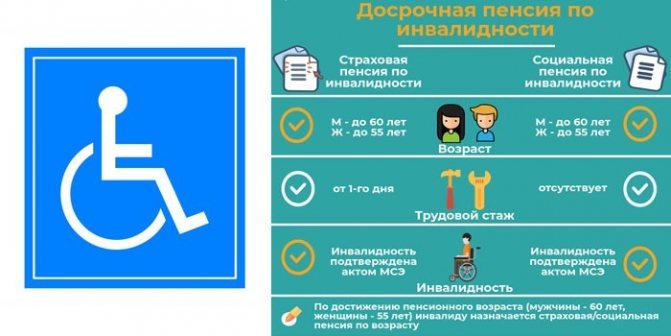According to the law, having a disability group of 3 is not an obstacle to work (with some reservations) and subsequent receipt of a pension for work activity. But first, you need to secure your special status by passing an examination.
Before this, however, you need to get a referral from a doctor and follow a certain sequence of steps. During a medical examination, specialists will assess the degree of limitations, health status and more.
As a result, they may be assigned group 3, in which it is not prohibited to perform work duties in the same or another place. Working disabled people apply for a pension according to the prescribed rules, which we will consider below.
General concepts
The group in question is assigned to individuals who are able to take care of themselves and perform normal activities. From the outside, they are often no different from healthy people. Group 3 disabled people in most cases remain able to work. They can switch to jobs with flexible hours or less labor intensity. Retraining is not excluded.
And yet, due to violations, as well as some limitations in opportunities, they are considered beneficiaries. For example, the state, in the form of material support, accrues a pension payment to holders of group 3, which is divided into:
— state
- paid from the state budget and available to WWII participants, military personnel, citizens with the insignia of the Siege of Leningrad, victims of radiation and man-made disasters;
— insurance
or labor (until January 2020) - consists of deductions received by the insurance and Pension Fund for the entire period of work, if the disabled person has work experience;
— social
- accrued to all disabled people without taking into account length of service and for category 3 it is usually equal to the minimum wage or increased if a citizen with disabilities has dependents.
Important
! A pension of a certain type is calculated in its own way, that is, in each case certain criteria are taken into account.
By the way, about disability. This concept is used if a person’s condition limits his activities in various aspects. At the same time, specialists can identify deviations in the mental, sensory, mental, and physical planes. Often, due to health problems, loss of ability to work is recorded.
The more serious the problem, the lower the assigned category. In this case, group 3 means a mild degree of restrictions, while group 1 is considered the most difficult. However, for any group, the state provides pensions and preferences to beneficiaries.
State pensions for disabled people
The state disability pension depends on the circumstances of the injury or illness. The size of the pension of a disabled person of group 3 is calculated based on the basic social pension (BSP). Its size after indexation in 2020 is 5,180 rubles. This means that disabled people of group III will be paid:
- 175% BSP for disability due to military injury;
- 150% BSP for disability due to a disease acquired during military service;
- 150% BSP to WWII participants;
- 100% BSP for blockade survivors;
- 125% BSP for disability due to a man-made disaster.
The legislative framework
The process of recognizing a person as disabled and assigning a group to him is carried out during a medical and social examination (MSE) in special bureaus. This procedure is prescribed by Law No. 181-FZ “On Social Protection of Disabled Persons in the Russian Federation” dated November 24, 1995. In addition, Order No. 95 of the Government of the Russian Federation defines the purpose of the group.
Order No. 17 of the Ministry of Labor of the Russian Federation regulates medical control, issuance of a certificate, approval of a disability category and other important components of the process. Orders No. 1 of the Ministry of Labor of the Russian Federation and No. 317 of the Ministry of Health are also quite informative in this regard.
Adjustment of payments when changing the disability group
To assign a pension, persons with disabilities must undergo a medical and social examination (MSE). It determines how much a person needs outside care, specialized treatment and whether he is entitled to a pension for people with disabilities. The diagnosis requires periodic re-examination - this may change the assigned group.
If the ITU is missed without a good reason, then pension payments are suspended. The frequency of re-examination depends on the disability group:
- For the 1st – 1 time in 2 years.
- For 2nd and 3rd – annually.
In certain situations, disability may be assigned for life. This is permitted by law if:
- The pensioner has reached the established age (for women - 55 years, for men - 60), or the next re-examination falls during this period.
- Over a certain period of time, a citizen’s existing disability category is constantly confirmed. For the 1st group it is 5 years, for the 2nd - 15 years, for the 3rd group there is no such opportunity (except for disabled military service people, for whom a 5-year period is established).
- A disabled person has pathologies and injuries included in a special list approved by Decree of the Government of the Russian Federation No. 247 of April 7, 2008 (this includes malignant tumors, blindness, amputation of limbs, etc.).
- By the next re-examination, a disabled person in military service will be 55 years old.
The reason for re-examination may be the disagreement of the pension recipient (or his guardian) with the established group of disabilities. In this case, it is necessary to submit an application for re-appointment of the ITU with a different composition (the law allows for a month for this). If the results do not satisfy the pensioner this time, he still has the right to challenge the decision by filing a lawsuit.
The procedure for assigning disability (or re-examination) takes place at the regional bureau of medical and social examination. If it is impossible for a citizen to visit this institution (for example, for bedridden patients), a medical and social examination is carried out at home. Regardless of the method, the patient must have a referral from the attending physician and test results.
The commission consists of at least 4 specialists (must include a psychologist). They assess the patient’s condition through a personal examination, studying the medical record, test results, etc. If necessary, they ask questions to the disabled person or his guardian (for example, about the possibility of independent care, etc.). As a result, a decision is made to assign/confirm a certain group or remove disability.
- Benefits for municipal employees - allowances, bonuses and free medical care
- 3 legal ways to avoid paying commissions for Sberbank transfers
- Sberbank will continue to service expired cards
Group decline
If the next re-examination reveals positive dynamics during the treatment of an illness or rehabilitation after an injury, then this indicates an improvement in health. In this situation, the ITU commission has grounds to downgrade the limitation group (for example, from 1st to 2nd). The procedure for recalculating the amount of pension payments in this case is as follows:
- The ITU Commission makes a decision on improving the condition of the person being examined. A special act is drawn up, which records the need to lower the disability group.
- A copy of this document is sent to the Pension Fund at the place of residence of the disabled person. This is an automatic, legally established procedure that does not require an application/application from the pensioner.
- Based on the received act, the Pension Fund performs a recalculation. The accrual of the disability pension in the changed amount will begin from the next month after the MSA.
Group Promotion
If, during the re-examination, the ITU commission comes to the conclusion that the dynamics are negative and the health condition of the disabled person is deteriorating, the disability group is increased (for example, from 2nd to 1st). The procedure includes the following steps:
- The ITU commission studies the card and test results of the person being examined, independently conducts an examination and diagnoses a deterioration in health (expressed, among other things, in a decrease in the ability to care for oneself). Based on the totality of the information received, specialists make a decision to increase the category of disability and document it.
- The examination report is received by the Pension Fund and serves as the basis for adjusting the amount of security. The participation of the recipient of payments (in the form of a written request) is not required.
- The new pension amount will be calculated starting next month.
Removal of disability
The procedure for removing disability (and canceling pension payments) is organizationally no different from cases of increasing/decreasing the group. The IEC Commission registers the patient’s cure, which deprives him of the opportunity to receive government benefits due to limited capabilities. The drawn up act is sent to the Pension Fund and payments are stopped.
What is the pension provided for a working disabled person of group 3?
The amount of the pension and the conditions for receiving it differ depending on the severity of the injury, illness, degree of restrictions, etc. To approve the amount of payments, the total work experience of a person with disabilities is taken into account, and the period for establishing group 3 does not play a role (that is, the citizen became disabled after completing his or her activity or during it).
Let us note one more point: before calculating a disability pension, the age of the person applying and his insurance experience (at least the minimum), which is associated with age, are taken into account. Approximately, this length of service increases by 1 year for every few years of age of a citizen with a disability.
In any case, the employer pays contributions for a disabled employee in the form of taxes and fees, which significantly affect the pension. At the same time, the due pension payments are indexed (recalculated) every year without a declaration.
The insurance pension benefit of a disabled person consists of the sum of two parts: the insurance pension itself and a fixed payment to it. According to Article 15 of Law No. 400-FZ dated December 28, 2013, the insurance pension part is calculated using the formula:
SP = IPK x SPK
,
Where:
- SP - the amount of the insurance pension;
- IPC - individual pension coefficient;
- SIPC is the cost of one coefficient as of the day the benefit was assigned.
The value of the SIPC is established by law and is indexed annually. In 2020, the cost of the pension coefficient is indexed by 6.6%, after which it will reach 93 rubles.
The size of the IPC of a disabled person depends on:
- the amount of insurance contributions paid by the employer for him to the pension fund;
- the amount of insurance experience, taking into account the periods included in it.
Fixed payment to the disability insurance pension of group 3
Simultaneously with the assignment of an insurance pension to disabled people, a fixed payment to it is established. Its size is determined by law and is subject to annual indexation. Depending on the disability group, the presence of dependents and other factors, this amount is adjusted.
- for disabled people of group 3 it is 50% of the base amount (5686.25) and was equal to 2843.13 rubles.
Persons who worked in the Far North or equivalent areas, provided that their insurance experience was at least 25 years (men) and 20 years (women), are provided with an increase in the amount of the fixed payment:
- by 50% if the recipient has worked in the Far North for at least 15 calendar years;
- by 30% if he worked for at least 20 years (calendar) in areas close to the conditions of the Far North;
For pensioners living in the Northern conditions, for the entire period of their residence there, the fixed payment increases by the regional coefficient applied for this territory. True, for persons who, at the same time as this right, also have the right to a pension increase for work in these areas, one increase of their choice is applied.
Additional payment to the insurance pension for disabled people of group 3 for having dependents
Among other things, the amount of the pension is adjusted according to the number of persons dependent on the recipient: if there are none, 2,843 rubles are credited, if there is one, 4,738 rubles are paid. If you have two dependents, you are entitled to 6,633 rubles, and if you have three dependents, 8,529 rubles. Thus, in addition to length of service in 2020, current marital status is also considered.
| Recipient category | Amount of fixed payment in 2020, rubles | |||
| No dependents | With 1 dependent | With 2 dependents | With 3 dependents | |
| Disabled person 3 groups | 2843,13 | 4738,55 | 6633,97 | 8529,39 |
Types of disability pensions
There are several types of pension benefits for people with disabilities. This type of pension is:
- Social. Appointed if the recipient has no work experience. This includes people with disabilities since childhood, people with disabilities of groups I, II and III, and disabled children.
- Insurance. It is received by persons with disabilities who have work experience (the duration does not matter, the minimum is 1 day). Employer contributions allow the employee to accumulate individual pension ratios (IPR). To calculate the amount of security of this type, a special formula is used. It is the sum of the base part and an additional payment, depending on the number of accumulated IPCs.
- For state pension provision. It is determined by participants of the Great Patriotic War, residents of besieged Leningrad, those who were injured during military service or those injured due to man-made disasters.

Payment amount
The table shows the pension amount for 2020:
| Category of disabled people | Social benefits for disabled people, rub. | Fixed payment (FB) to an insurance type pension, rub. |
| Children | 12432,44 | — |
| Since childhood, group I | 12432,44 | 9965,80 |
| Group I | 10360,52 | 9965,80 |
| Since childhood, group II | 10360,52 | 4982,90 |
| Group II | 5180,24 | 4982,90 |
| Group III | 4403,24 | 2491,45 |
The column with a fixed surcharge (the basic part of the insurance pension) provides data for a situation where the recipient has no dependents. If they are available, the payment amount increases. The table shows data for disability group I:
| Number of dependents | FV size, rubles |
| 0 | 9965,80 |
| 1 | 11626,77 |
| 2 | 13287,74 |
| 3 or more | 14948,71 |
The amount of state pension provision depends on which category the recipient belongs to. The table shows the most common examples for 2020:
| Disability group | Due to injury in military service | Liquidators of man-made disasters | Participants in hostilities |
| I | 30 205,59 | 25 171,33 | 25 171,33 |
| II | 12 585,63 | 12 585,63 | 10 068,50 |
| III | 7 488,50 | 5 348,93 — 10 697,85 | 6 418,71 |
What documents may be needed when applying for a pension?
An applicant for pension payments cannot do without:
- Russian Federation passports;
— certificates of disability indicating the group;
— work book or other document confirming work experience.
As additional applications that may be required, a group 3 disabled person should prepare:
— a document about dependents (their absence or presence);
— an extract from the last place of work about the amount of salary for the past 2 months;
- certificate of departure and temporary residence abroad, if this is the case;
- certificate of change of full name (partially or completely), if this action was performed;
- a paper on obtaining a special status (disability) as a result of a radiation or man-made disaster (for those faced with such an experience).
A more detailed list of additional documents can be found in the Pension Fund, taking into account the specific situation. But it is important to understand that the right to a state pension comes into force when a citizen passes the ITU and receives group 3 with appropriate confirmation of this fact in the form of a certificate, certificate, etc.
Grounds for recalculation
The regulatory framework governing recalculation depending on the assigned pension provision is defined in the following federal laws:
- dated December 15, 2001 No. 166-FZ “On state pension provision in the Russian Federation” - for social and state pensions;
- dated August 28, 2013 No. 400-FZ “On Insurance Pensions” - to provide an insurance type.
The reasons for changing the amount of pension payments (increase, decrease) or their termination are:
- assignment of a new disability group;
- moving a pensioner for permanent residence to the Far North.
These options are relevant for all types of pensions. A separate case of increase is the annual adjustment of the amount of payments. In 2020 it is planned:
- January 1 – for insurance pensions for non-working citizens.
- April 1 – for Pension Fund benefits.
- April 1 – for social pensions.
- October 1 – for state pensions.
All types of collateral listed in the list will undergo indexation - an increase in the size of payments to compensate for inflationary processes in the economy. The increase coefficient differs for different types of payments (for example, labor pensions will increase by 7.05%, and social pensions by 2.4%).
A separate case is the calculation of disability insurance pensions for employed persons. Starting from 2020, indexation is not carried out for it, but since working pensioners increase their work experience, for this reason payments are recalculated on August 1. After the citizen retires, the pension will be adjusted taking into account all previously missed indexation coefficients.
- Cystic fibrosis - what kind of disease is it?
- How to get maternity capital during the COVID-19 pandemic
- Why do COVID-19 patients need rehabilitation?
Changing the fixed payment amount
The reasons for adjusting the size of the PV are:
- Change in the number of disabled family members. For example, the birth of a child or, conversely, one of the children reaching adulthood - for the first case, payments will increase, for the second, they will decrease. For example, when twins are born to a disabled person of the 1st group, who had no children before, the pensioner’s EF will increase from 9,965.80 rubles. up to 13,287.74 rub.
- 80 year old pensioner. When it is reached, the assigned base payment is doubled.
- Moving for permanent residence to the northern regions. In this situation, the basic part of the citizen’s insurance coverage is multiplied by the regional coefficient (RC). The amount of the increase varies depending on where you live. For example, in the Krasnoyarsk Territory for residents of Norilsk the RK will be 1.8, and for residents of Yeniseisk or Lesosibirsk - 1.3. When leaving the northern regions, a citizen loses the right to the regional coefficient.
- Development (or confirmation) of a legally established preferential length of service for the Far North and similar areas (for example, men require 15 years of service). If this period was before 2002, then the Pension Fund may not have the necessary information and documentary evidence will be required. After confirmation of the preferential length of service, the amount of the disability pension will be increased for the applicant.

The table shows how the basic part of payments changes for disabled people of the 1st group with a proven northern 15 years of experience:
| Number of disabled dependents | PV value, r. |
| 0 | 14 948,70 |
| 1 | 17 440,16 |
| 2 | 19 931,61 |
| 3 or more | 22 423,05 |
Recalculation of the insurance part
Such an adjustment is permitted in the following situations:
- The emergence of new data about the work experience of the recipient of payments (for example, when applying for a pension, the employee did not collect all the necessary documents confirming the time of work). This is relevant for the period before 2002 - later information was fully recorded by the Pension Fund.
- Accounting for non-insurance periods. This includes activities of social significance (caring for a child under 1.5 years of age, conscription service, etc.), which adds 1.8 IPC per year of such employment. This procedure for recalculating a pension will not always bring benefits to the recipient (but, most likely, it will be beneficial for women with several children and short service). By law, a pensioner can leave the same amount of security if, upon recalculation, his income becomes less.
- Continuation of work activity. Every year that a pensioner works, the number of IPC increases (which increases the insurance part of the pension). This adjustment is carried out annually on August 1 automatically, but if necessary, a citizen can prepare an application for recalculation and submit it to the Pension Fund (for example, if he has worked for only six months and is going to retire).
Amount of increase in minimum compensation
Now let’s consider such an issue as the supplement to the pension accruals of a working disabled person of group 3. Alas, for persons in this category, unlike holders of groups 2 and 1, no allowances are provided in 2020. Group 3 disability allows you to choose one of the options, namely: labor pension and EDV or social pension and EDV.
The EDV is added as a supplement to the basic pension, depending on the set of social benefits used (left in kind). Social services mean:
— free travel on public transport;
— vouchers to the sanatorium issued every year free of charge;
— prescription medications (they can be obtained at a discount of up to 50% or at the expense of the state).
You can refuse the listed preferences in full or in part by choosing their cash equivalent. By the way, the EDV will be indexed on February 1, 2020 and, together with the NSI for disabled people of group 3, will amount to 2,244.85 rubles. As for the social package, it is equal to 1,155.06 rubles, where 889.66 rubles are for medicines, and 127.77 rubles are for travel in transport and, finally, 137.63 rubles are for vouchers.
| disability group | EDV with NSU | EDV without NSO |
| disabled person 3rd group | 2 227,55 | 1 072,49 |
In general, there are many nuances that determine the amount of additional payments and pensions for group 3, so it is worth consulting directly in your region.
Indexation of payments for disabled people
In Russia, there is a change in the amount of not only insurance payments, but also social ones. The level of first benefits increases depending on inflation rates and the number of contributions made to the Pension Fund. They are made by the enterprise where the citizen is employed.

In addition, the increase in payments is reflected in the profitability of the fund. The cost of living affects the increase in social benefits. EDV and the range of social services and other allowances are also increasing.
The table reflects changes in amounts that occurred due to indexation.
| Type of payment | Before indexation (in rubles) | After (in rubles) |
| Fixed part | 5034 | 5334 |
| Social benefits for disabled people of group 1 | 10068,53 | 10481,34 |
| For disabled people of group 2 | 5034,25 | 5240,65 |
| For category 3 disabled people | 4279,14 | 4454,58 |
| Disabled children from childhood and disabled children | 12082,06 | 12577,42 |
| Category 2 disabled people from childhood | 10068,53 | 10481,34 |
The supplement for dependents depends on their number.







